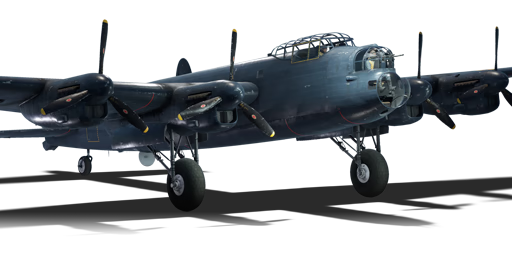



After World War II, many Lancaster bombers were refitted into civilian roles, such as transport, mail delivery, and search and rescue. 59 Lancaster B.Is and B.VIIs were ordered by the French Aéronavale to be converted into a maritime patrol aircraft. The aircraft, later designated Lancaster MR.7, were delivered by Avro during 1952-53. These would be the last direct variant of the Lancaster ever built. The MR.7 flew until the mid-1960s by four squadrons stationed in France and New Caledonia in the maritime reconnaissance and search-and-rescue roles.
It was introduced in Update "La Royale". The Lancaster MR.7 in the French tech tree is not identical at all to the Lancaster in the British tech tree. While it still carries a very large payload, enough to deal with a base in air battles and carpet bomb a good chunk of the map, this one has a more limited defensive armament that covers only the back and front of the aircraft. It also has access to a radar. However, the main difference is its inability to carry the 12,000 lb bomb found on the British Lancasters, in fact, its largest bomb is a 1,000 lb bomb, paired with more smaller bombs in the bomb bay.
flaps
flaps
flaps
brake
| Belt | Belt filling | Armor penetration (mm) at a distance: | |||||
|---|---|---|---|---|---|---|---|
| 10 m | 100 m | 500 m | 1000 m | 1500 m | 2000 m | ||
| API-T/AP/AP/I | 30 | 27 | 20 | 13 | 9 | 6 | |
| AP/AP/AP/API-T | 30 | 27 | 20 | 13 | 9 | 6 | |
| AP-I/I/AP-I/API-T | 28 | 26 | 18 | 11 | 7 | 4 | |
| Belt | Belt filling | Armor penetration (mm) at a distance: | |||||
|---|---|---|---|---|---|---|---|
| 10 m | 100 m | 500 m | 1000 m | 1500 m | 2000 m | ||
| T/AP/AP-I/Ball/Ball/I | 13 | 12 | 7 | 3 | 2 | 0 | |
| T/AP/AP/AP | 13 | 12 | 7 | 3 | 2 | 0 | |
| T/AP-I/AP-I/AP-I | 13 | 12 | 7 | 3 | 2 | 0 | |
6 × M.C. 500 lb Mk.I bomb
M.C. 1000 lb Mk.I bomb
6 × M.C. 500 lb Mk.I bomb
6 × M.C. 1000 lb Mk.I bomb












Flight performance | |
|---|---|
Survivability |
|---|
Weaponry | ||
|---|---|---|